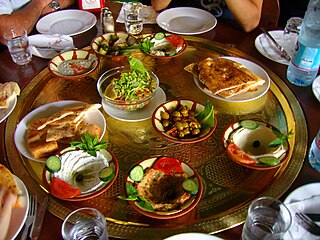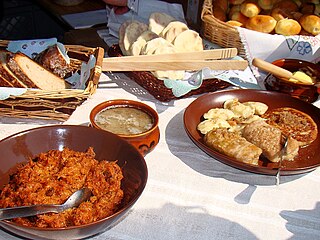
Ham is pork from a leg cut that has been preserved by wet or dry curing, with or without smoking. As a processed meat, the term ham includes both whole cuts of meat and ones that have been mechanically formed.

The cuisine of the Southern United States encompasses diverse food traditions of several subregions, including Tidewater, Appalachian, Ozarks, Lowcountry, Cajun, Creole, African American Cuisine and Floribbean cuisine. In recent history, elements of Southern cuisine have spread to other parts of the United States, influencing other types of American cuisine.

Smoking is the process of flavoring, browning, cooking, or preserving food by exposing it to smoke from burning or smoldering material, most often wood. Meat, fish, and lapsang souchong tea are often smoked.

Louisiana Creole cuisine is a style of cooking originating in Louisiana, United States, which blends West African, French, Spanish, and Native American influences, as well as influences from the general cuisine of the Southern United States.

Lapsang souchong or Zhengshan xiaozhong is a black tea consisting of Camellia sinensis leaves that may be smoke-dried over a pinewood fire. This smoking is accomplished either as a cold smoke of the raw leaves as they are processed or as a hot smoke of previously processed leaves. The intensity of the smoke aroma can be varied by locating the leaves closer or farther from the source of heat and smoke or by adjusting the duration of the process. The flavour and aroma of smoked lapsang souchong is described as containing empyreumatic notes, including wood smoke, pine resin, smoked paprika, and dried longan; it may be mixed with milk but is not bitter and usually not sweetened with sugar. The tea originates from the Wuyi Mountains region of Fujian and is considered a Wuyi tea. It is also produced in Taiwan. It has been labelled as smoked tea, smoky souchong, tarry lapsang souchong and lapsang souchong crocodile. While the tea leaf grading system adopted the term souchong to refer to a particular leaf position, lapsang souchong may be made with any leaf of the Camellia sinensis plant, though it is not unusual for the lower leaves, which are larger and less flavourful, to be used as the smoking compensates for the lower flavour profile and the higher leaves are more valuable for use in unflavoured or unblended teas. In addition to its consumption as a tea, lapsang souchong is also used in stock for soups, stews and sauces or otherwise as a spice or seasoning. Beginning in the early 21st century, an unsmoked variety of lapsang souchong was developed in the village of Tong Mu Guan in the Wuyi mountains. The unsmoked variety has become increasingly popular, particularly in the Chinese domestic market.

Meze is a selection of small dishes served as appetizers in Levantine, Turkish, Balkan, Armenian, Kurdish, and Greek cuisines. It is similar to Spanish tapas and Italian antipasti. A meze may be served as a part of a multi-course meal or form a meal in itself. Meze are often served with spirits such as arak, rakia, raki, oghi, ouzo, or grappa at meyhane and ouzeri or at regular restaurants.

Polish cuisine is a style of food preparation originating in and widely popular in Poland. Due to Poland's history, Polish cuisine has evolved over the centuries to be very eclectic, and shares many similarities with other national cuisines. Polish cooking in other cultures is often referred to as à la polonaise.

Austrian cuisine consists of many different local or regional cuisines. In addition to Viennese cuisine, which is predominantly based on the cooking traditions of the Habsburg Empire, there are independent regional traditions in all the states of Austria.

Smoked meat is the result of a method of preparing red meat, white meat, and seafood which originated in the Paleolithic Era. Smoking adds flavor, improves the appearance of meat through the Maillard reaction, and when combined with curing it preserves the meat. When meat is cured then cold-smoked, the smoke adds phenols and other chemicals that have an antimicrobial effect on the meat. Hot smoking has less impact on preservation and is primarily used for taste and to slow-cook the meat. Interest in barbecue and smoking is on the rise worldwide.
Romanian cuisine is a diverse blend of different dishes from several traditions with which it has come into contact, but it also maintains its own character. It has been influenced mainly by Turkish but also a series of European cuisines in particular from the Balkan Peninsula and Hungarian cuisine as well as culinary elements stemming from the cuisines of Central Europe.
Serbian cuisine is a Balkan cuisine that consists of the culinary methods and traditions of Serbia. Its roots lie in Serbian history, including centuries of cultural contact and influence with the Greeks and the Byzantine Empire, the Ottomans, and Serbia's Balkan neighbours, especially during the existence of Yugoslavia. Historically, Serbian food develops from pastoral customs that involved the keeping of sheep in mountain highlands, in a climate and regional context that favoured animal husbandry over vegetable farming; Serbian food is therefore traditionally richer in animal products and basic grains—corn, wheat and oats—than fresh vegetable dishes. Following the abandonment of widely practiced pastoral lifestyles, Serbian food emerged through the Middle Ages heavily dependent not on lamb or mutton, but on the keeping of pigs for the annual cull and the production of various cured meats, such as sausages, bacon and ham products.

Hungarian sausages are sausages found in the cuisine of Hungary. Hungary produces a vast number of sui sausage types. They may be boiled, fresh or dried, and smoked, with different spices and flavors, "hot" or "mild". Many were influenced by their neighbors and brethren.
An acquired taste is an appreciation for something unlikely to be enjoyed by a person who has not had substantial exposure to it. It is the opposite of innate taste, which is the appreciation for things that are enjoyable by most people without prior exposure to them.

Cured pork tenderloin is found in various cuisines in Mediterranean Europe and South America. It is typically salted or brined then dry-cured or smoked.





















































